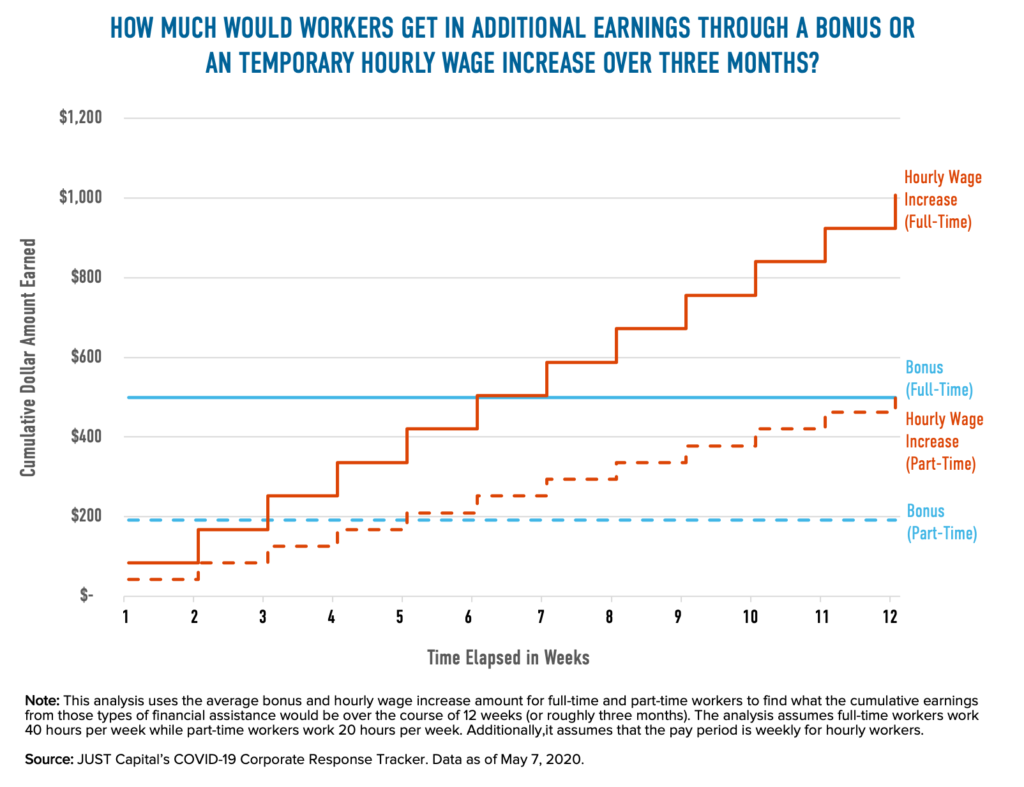Behind the Chart: Comparing Bonuses and Hourly Wage Increases for Frontline Workers During Coronavirus
Last week, JUST Capital released a report exploring what types of financial assistance America’s 100 largest employers – monitored in our COVID-19 Corporate Response Tracker – have provided to their essential workers to compensate them for putting their health at risk and help mitigate financial instability during the pandemic. We found that 20 companies announced temporarily increasing hourly wages or offering hazard pay, and 18 companies announced providing one-time bonuses to their employees. Our analysis also posited that companies that are financially able to do so should prioritize increasing hourly wages over providing one-time bonuses. In this piece, we unpack this argument in depth.
Across the 100 companies we analyzed, those that announced a temporary wage increase added an average of $2.11 to employee’s hourly earnings. Companies that announced offering a one-time bonus gave full-time workers $500 and part-time workers $192 on average.
At first blush, bonuses seem to give workers access to much more cash than a temporary bump to hourly wages. Having this cash upfront can help workers cope with unexpected expenses that arise due to health emergencies, shifts in employment status, switches in child care arrangements during school closures, or other changes to financial circumstance during the pandemic. But as demonstrated by the chart below — which was also featured in our report — the longer-term outlook is different: Over time, the cumulative earnings from a temporary wage increase outpace those from a one-time bonus.

The hypothetical example illustrated in the figure above uses (1) the average one-time bonus amount and (2) the average hourly wage increase amounts for both full- and part-time workers to chart what cumulative earnings under each financial assistance program look like over a three month horizon.
In this scenario, imagine that Company A announced a one-time bonus for its full- and part-time workers of $500 and $192, respectively, while Company B announced a $2.11 per hour wage increase for both its full- and part-time workers paid on a weekly basis. By the end of the first week, full- and part-time workers at Company A would have collected and extra $500 and $192, respectively, and workers at Company B would have only collected an extra $84 and $42. In other words, full- and part-time workers at Company A would have earned an additional 6.0 and 4.6 times the amount of their counterparts, respectively, at Company B.
Right after the end of the fifth week, however, the cumulative earnings from an hourly wage increase for part-time workers at Company B start exceeding the cumulative earnings from a part-time worker’s bonus at Company A. Around the end of the sixth week, the cumulative earnings from an hourly wage increase for full-time workers at Company B eclipse the cumulative value of the bonus for full-time workers given by Company A. By the end of the third month, full-time workers at Company B will have cumulatively earned 2.0 times as much in extra wages as full-time workers at Company B. And part-time workers at Company B would have cumulatively garnered over 2.6 times as much in additional wages as their counterparts in Company A.
In deciding between following the plans set up by Company A (bonuses) or those implemented by Company B (temporary wage increases), companies are implicitly being asked to think about whether COVID-19 will have short-term impact on their businesses and workers or a long-term one.
There is a lot of uncertainty around how the COVID-19 pandemic will continue to play out, but many experts have speculated that the crisis will have long-term impacts on public health, our economy, and many other dimensions of our daily lives. In an outstanding example from our analysis, Charter Communications announced that it would increase the wages of its hourly workers to $20/hour permanently by 2022, while many other companies’ pay increases are set to expire this month. Given these long-term impacts, however, companies that are contemplating between the two actions or are financially able to do so should consider increasing workers’ hourly wages – and consider making these increases permanent.






